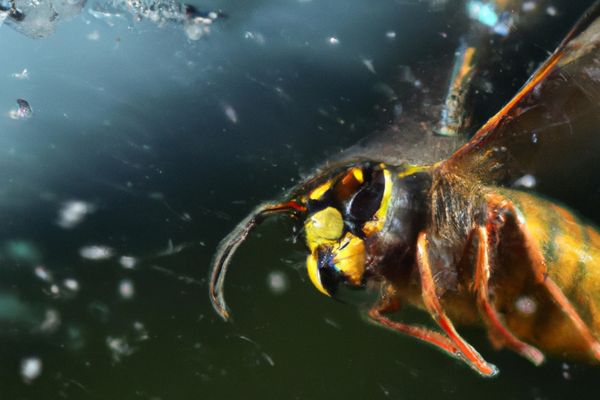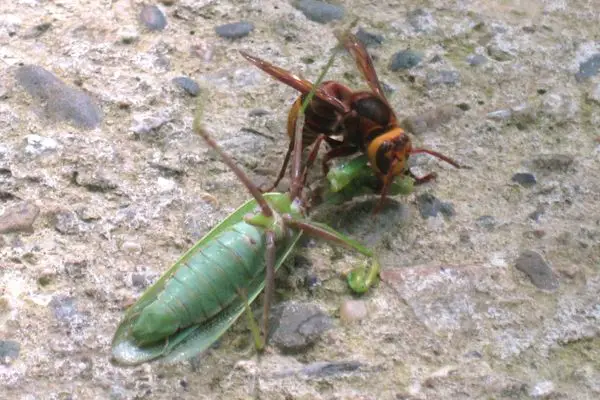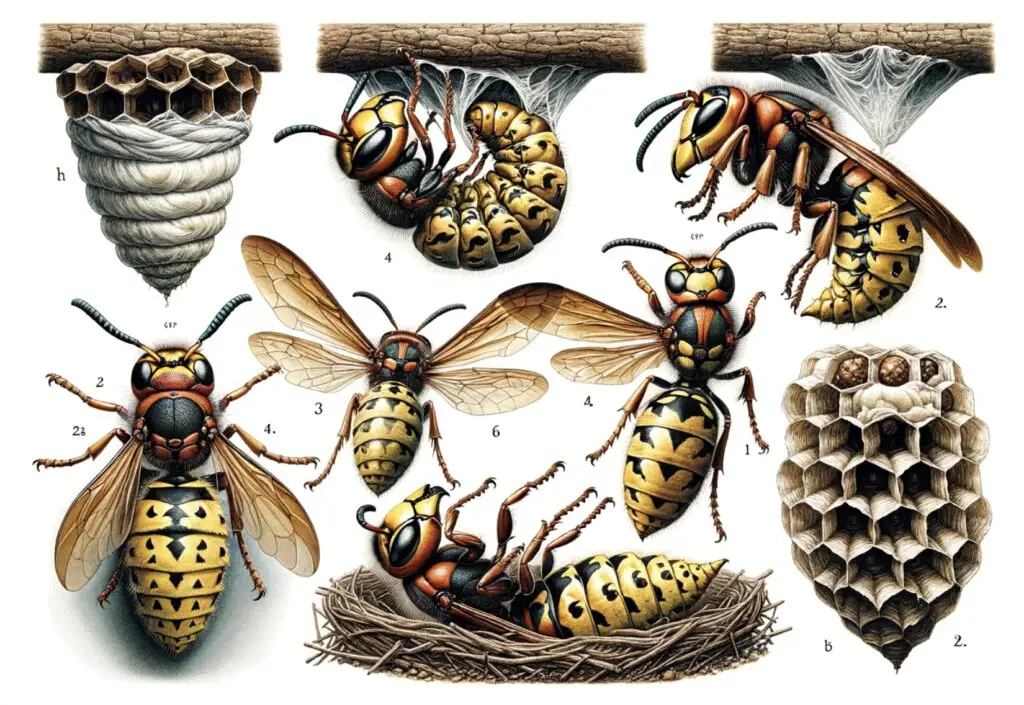Hornets, like many insects, can survive for a period without food, but the exact duration depends on various factors.
Generally, hornets can live for several days to a few weeks without food and the queen can live around 1 year.
This survival time frame is influenced by several factors including environmental conditions, biological aspects, and social behaviors.
Contents
The Survival Time Frame of Hornets Without Food
Factors Affecting Survival Without Food
Hornets’ survival without food is not a straightforward matter. Several factors play a critical role. Firstly, the species of the hornet is a significant determinant.

Different species have varying metabolic rates and survival strategies. Secondly, the age and health of the hornet are crucial. Younger, healthier hornets generally withstand longer periods of food scarcity compared to older or diseased ones.
Moreover, the time of year affects their survival. Hornets tend to be more active and hence require more energy during warmer months. During colder periods, their metabolic rate decreases, which can prolong their survival without food. Additionally, the availability of water can influence their survival time. Hornets can survive longer with access to water, even in the absence of food.
Comparison of Survival Times in Different Conditions
Studies and observations suggest significant variations in survival times under different conditions. For example, in temperate climates during the active season, a hornet might only survive a few days without food. In contrast, during hibernation or in cooler temperatures, their metabolic rate drops, and they can survive much longer, possibly weeks.

Statistical data on hornet survival without food is somewhat scarce. However, observational studies have noted that under laboratory conditions with controlled temperature and humidity, some hornets can survive up to two weeks without food, assuming they have access to water.
The Role of Environmental Conditions in Hornet Survival
Temperature and Humidity Impact
Temperature and humidity are paramount in determining a hornet’s survival without food. Hornets are cold-blooded insects; their body temperature and metabolic rate are directly influenced by the ambient temperature. In warmer conditions, their metabolic rate increases, leading to a higher energy demand and consequently a shorter survival period without food.

Conversely, in cooler temperatures, their metabolic rate decreases. This physiological adaptation helps them conserve energy and survive longer periods of food scarcity. Humidity also plays a role; in high humidity environments, hornets may lose less water through evaporation, which can indirectly affect their survival.
The Influence of Habitat on Food Scarcity and Predation
The habitat of hornets significantly influences their access to food and their risk of predation, both of which can affect their survival without food. In areas where food is abundant, hornets can build up reserves which may help them survive periods of scarcity.
On the other hand, in environments with high predation risks, hornets may expend more energy in defensive actions or in relocating their nests, which can reduce their survival time in the absence of food.

Hornets living in urban areas may have different survival rates compared to those in rural or forested areas due to variations in food availability and environmental stressors. In urban settings, the availability of human waste can provide a more consistent food source, potentially increasing their survival time during periods of natural food scarcity.
Biological Factors Influencing Survival Without Food
Age and Size Considerations
The age and size of hornets significantly impact their ability to survive without food. Younger hornets, especially larvae, are more vulnerable during food shortages due to their growing bodies’ higher nutritional requirements.

Adult hornets, particularly larger ones, have more fat reserves and can generally withstand longer periods without food. However, their larger body size also means a higher metabolic rate, which can counteract this advantage.
The Role of Metabolic Rate
A hornet’s metabolic rate is a key factor in determining its survival without food. Hornets with a higher metabolic rate burn energy faster and therefore require more frequent feeding. Factors such as activity level, temperature, and even the hornet’s role within the colony (such as workers or queens) influence metabolic rate. Workers, who are more active in foraging and maintaining the nest, may have a higher metabolic rate compared to queens or drones.
Reproductive Status and Its Impact
The reproductive status of a hornet can also affect its survival without food. For instance, a queen hornet, especially one preparing to lay eggs or actively laying, requires more energy and, thus, food. Without adequate nutrition, her reproductive capacity may diminish, and her overall survival may be compromised. In contrast, non-reproductive individuals may survive longer due to lower energy demands.
Social Behavior and Survival
Cooperative Foraging and Food Sharing
Social behavior plays a crucial role in the survival of hornets during food scarcity. Hornets exhibit cooperative foraging, where worker hornets leave the nest to find food and share it with the rest of the colony. This behavior is essential for the survival of non-foraging members like larvae and the queen. During times of food scarcity, the ability of a few
foragers to locate and share food can be critical for the colony’s survival.
Hierarchies and Resource Allocation
In hornet colonies, there are distinct hierarchies and systems of resource allocation that can influence survival during food shortages. Typically, larvae and the queen are prioritized for food distribution, as they are crucial for the colony’s future. Worker hornets may sacrifice their nutrition for the greater good of the colony, which can affect their individual survival rates.
In extreme cases of food scarcity, some hornet colonies may even resort to cannibalism, where the weaker or less essential members are consumed to sustain the rest of the colony. This grim survival strategy underscores the harsh realities that hornets face in their struggle for survival without adequate food resources.
Case Studies: Hornets in Extreme Conditions
Surviving in Arid Environments
Hornets in arid environments face unique challenges, including extreme temperatures and limited food and water sources. Studies have shown that hornet species adapted to these environments have developed strategies to cope with these harsh conditions.
For example, they may have a more robust exoskeleton to reduce water loss, or their foraging patterns may be adjusted to conserve energy and maximize the efficiency of food collection.
Hornets in Temperate Climates
In contrast, hornets in temperate climates deal with different challenges, such as varying seasonal food availability and temperature fluctuations. These hornets may have developed strategies like hibernation or storing food in their nests to help them survive periods of scarcity. The seasonal behavior of these hornets, such as reducing activity in winter, is a crucial adaptation for their survival without regular food sources.
Conclusion
In summary, the question of how long hornets can live without food encompasses a complex interplay of environmental, biological, and social factors. While it’s challenging to provide a definitive time frame due to these varying influences, we can conclude that hornets can survive from several days to a few weeks without food under different conditions.
The resilience and adaptability of hornets are evident in how they respond to food scarcity. Environmental conditions like temperature and humidity significantly affect their metabolic rate and, consequently, their survival duration.
Biological factors, including age, size, metabolic rate, and reproductive status, further complicate this survival equation. Moreover, the social structure and behaviors of hornet colonies, such as cooperative foraging, food sharing, and hierarchical resource allocation, play crucial roles in ensuring the survival of the colony during periods of scarcity.
Through case studies of hornets in arid and temperate climates, we see the remarkable adaptability of these insects to various extreme conditions. Their ability to modify foraging behaviors, regulate metabolic rates, and even resort to drastic measures like cannibalism in dire situations, underscores their tenacity and survival instinct.
Understanding how long hornets can survive without food not only satiates our curiosity about these insects but also offers insights into their ecological roles and the delicate balance of ecosystems they inhabit. As we continue to study and appreciate these complex creatures, we gain a deeper appreciation for the intricate web of life and the adaptability of species within it.
Hornets, often misunderstood and sometimes feared, are a testament to nature’s resilience and the intricate strategies evolved over millennia to cope with the challenges of survival. Their story is a compelling chapter in the broader narrative of life’s persistence and adaptability on our planet.
References:
- “The Fragile Nature of Hornets.” Humans for Survival. Retrieved from https://www.humansforsurvival.org/the-fragile-nature-of-hornets/
- “How Long Do Hornets Live Without Food.” Flavorful Food Network. Retrieved from noffn.org
- “How Long Can a Hornet Live Without Food.” Flavorful Food Network. Retrieved from noffn.org
- “What Do Hornets Eat? (Diet & Facts).” American Tarantula & Animals. Retrieved from www.atshq.org
- “What is the length of time that a hornet can survive without food or water?” ZooNerdy. Retrieved from https://zoonerdy.com/what-is-the-length-of-time-that-a-hornet-can-survive-without-food-or-water/




